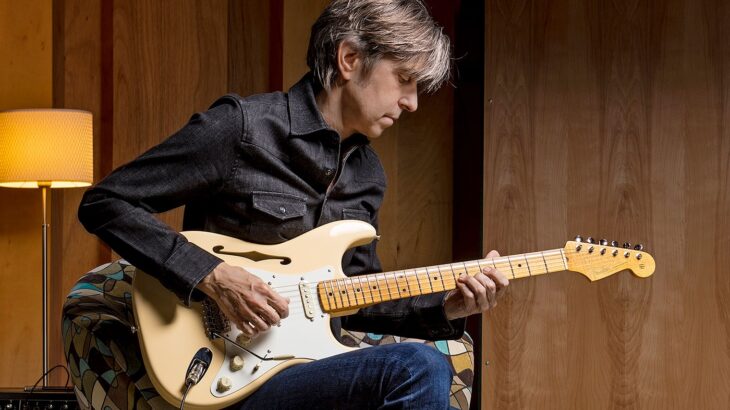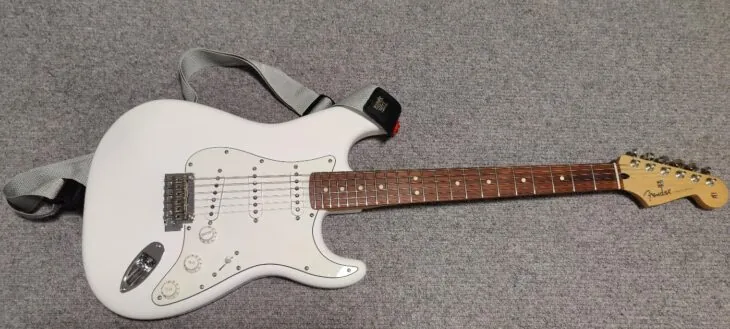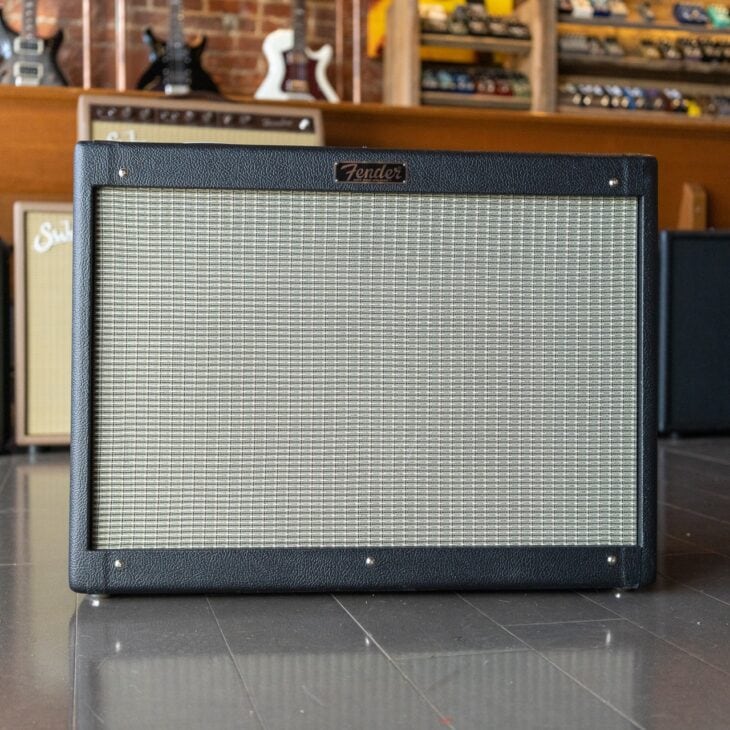Mention Eric Johnson to any serious guitar player you know and watch their reaction. Most of us speak in hushed, reverent tones of the man’s impeccable phrasing, terrifying technical ability, and excellent taste in jackets (see “Cliffs of Dover” for evidence). Above all, however, is Eric Johnson’s instantly identifiable tone.
Straddling sweetness and power in equal measure, the Eric Johnson tone is something of a Holy Grail sound for most guitarists. While, like all great players, most of his sound comes from Johnson’s faultless technique, most of us can get close to his sound with the right gear.
In this article, I’ll take you on a tour of the essential gear and vital tweaks you’ll need to capture Eric Johnson’s legendary sound.
Table of Contents
Eric Johnson Guitars

The core of the Eric Johnson sound is a heavily customized Fender Stratocaster. Fender actually released a few Eric Johnson signature model Strats, including a replica of his favored 1954 Strat.
While pretty much any Stratocaster will do to get you in the ballpark of the Johnson sound, there are a few things to bear in mind before embarking on this tone journey.
The first, and most important distinction, is the inclusion of Johnson’s own single-coil pickups, set to his exacting specifications. These pickups feature a mixture of Alnico 3 and Alnico 5 staggered magnets to help capture Johnson’s distinctive edge-of-breakup tone.
Johnson’s Strat is made of typical Strat tonewoods, an alder body with a finished maple neck.
This means that, with the bare bones of the instrument, you can use a cheaper Stratocaster model such as the excellent Mexico-made Player Strat, and install the Johnson pickups, and still end up with a more affordable guitar than the signature model.

Another key modification that Johnson makes, and one that is responsible for the natural sustain and resonance he achieves with his Stratocaster, is the absence of string trees on his Strat headstock.
The B and E strings on a typical Strat headstock, because of the six-a-side headstock, are anchored by string trees. This helps keep them secure in the nut. Eric Johnson removed the string trees on his guitar as he felt they interfered with the guitar’s sustain.
You can do this, too, but you’ll need to lower the pitch of your guitar’s headstock. This will naturally descend the angle of the strings, adding even more sustain.
Johnson’s preference is for the Fender V shape, but neck shape has more to do with your playing than with your tone, so you can use pretty much any comfortable neck profile. The Fender C profile works fine for this tone in my experience.
Eric Johnson Amps
It will come as no surprise to any guitarist who has heard Eric Johnson’s tone to learn that he uses multiple amps, often switching between them within a single song.
Johnson usually runs one or two amps for his clean sound, switching to an overdriven Marshall amp for his dirty tone.
Eric Johnson has roadies to carry his gear. I don’t. If you’re like me, loading one amp into a gig is enough work as it is, let alone three (or more).
For this reason, I’d recommend getting an amp that has multiple channels, with particular emphasis on getting a beautiful clean tone as a starting point. It’s easy to dirty up a great clean tone, and it’s hard to clean up a great drive tone.
For this reason, the Fender Hot Rod is my pick for an Eric Johnson style tone.

Use the clean channel for your base Johnson clean tone. Use the slight dirt as a rhythm tone. Use the third lead channel as your lead tone.
It sounds deceptively simple, until you realize each of Johnson’s on-stage amps has a totally unique pedal path. Before we delve into the right pedals for his tone, we’re going to touch on the best amp settings for the Eric Johnson sound.
Eric Johnson Amp Settings
Most of Eric Johnson’s tone comes not from his amp settings, but from his playing technique.
His amp settings are dialed in to maximize the effect of his technique.
The main thing to master when seeking Johnson’s smooth, dynamic tone is downward pickslanting. You just need to hold your pick as usual, and angle your picking hand down toward the floor, with the point of the pick pointing slightly upward.
This gives you greater speed and accuracy when striking strings on the upstroke, essential for a smooth alternate picking technique like Eric Johnson’s.
Volume: 9-10
You need a lot of crispy, natural amp volume for this tone. You want the poweramp at the edge of breakup, and for a Fender amp this requires cranking the volume.
Bass: 5
Stratocasters are naturally trebly, so you need a present amount of low end in the mix to get Eric Johnson’s thickness.
Mids: 4
This is not a mid-forward tone, so keep the mids lower than the bass
Treble: 3
Some reports have Eric Johnson’s treble tone even lower than 3. Start at 3 and adjust to taste.
Presence: 0
Critical to this tone is the near-total lack of the Presence knob, giving Eric Johnson’s tone that elusive “faraway” quality.
Eric Johnson Pedals
Eric Johnson’s guitar tone requires the creative use of some essential pedals.
For the clean tone, you’ll want a nice stereo chorus, like the reliable Boss CH-1, and an 80s-style digital delay, such as the Boss DD-8.

Tweak your pedal settings to get the right sound, but this should be enough to capture Johnson’s basic clean tone.
The main tone we want to capture, however, is that sweet, dynamic lead sound.
Eric Johnson likes using a light drive to begin with, reportedly a TS808 with the gain and volume set very low.
To further add character to this signal, Eric Johnson uses a vintage Dallas-Arbiter Fuzz Face and a genuine Maestro Echoplex.
These aren’t practical for most guitarists, myself included. I’d recommend the Germanium Fuzz Face as this is similar to the Arbiter. Instead of a full Echoplex delay, the more important feature is the Echoplex preamp, which Dunlop faithfully recreated, and is one of my personal favorite tone-conditioning pedals.
Final Word
Eric Johnson’s tone is elusive, and most of it comes from his fingers. With the right gear, as outlined in this article, you can recreate some of the magic, and get cracking on mastering “Cliffs of Dover” to your heart’s content.

